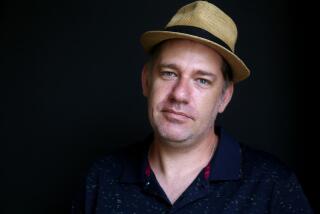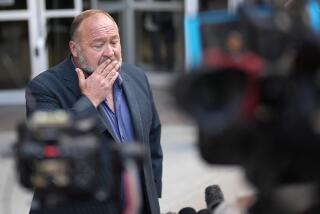Light at the End of Chapter 11 : Bankruptcy: After a decade of reorganization, the complex and bizarre case of Kings Point Corp. seems to be nearing a conclusion.
- Share via
In the late 1970s, Laird International Studios operated the Culver City lot where such movie classics as “Gone With the Wind” were filmed. Laird’s parent, Kings Point Corp. in Sherman Oaks, then went into bankruptcy in 1982, and that bankruptcy case has now lasted more than twice as long as the Civil War itself.
Kings Point is in an astounding 10th year of reorganization under Chapter 11 of the U.S. bankruptcy laws. It has taken that long for the company’s trustee to secure title to Kings Point’s assets, to sell them so the proceeds can go to the company’s thousands of creditors, and for the creditors to agree over their rights to the cash, which totals $56 million.
At the center of this saga are two men: the 71-year-old trustee, Curtis B. Danning, a Century City lawyer and 35-year veteran of bankruptcy cases, and Joseph R. Laird, 69, who started and owned Kings Point until Danning took over a decade ago.
Yet Laird to this day follows the company and complains that Danning has mismanaged the assets Laird once amassed. Danning scoffs at the complaint, saying, “I’m pretty proud of what I did.”
What he did was shepherd the company through a case that’s bizarre even by the normally complex standards of bankruptcy proceedings.
It involves not only the famous studio lot but coal-mining partnerships, time-share condominiums in Hawaii, a major tax-fraud trial that sent Laird to prison, several bankruptcy judges and about 5,000 individual investors nationwide who are the bulk of Kings Point’s creditors.
An end finally appears in sight. Danning last week filed a plan of reorganization with U.S. Bankruptcy Judge William J. Lasarow in Los Angeles, a plan Danning expects to be approved by year’s end.
Moreover, Danning predicts that most of Kings Point’s investors will get back 100 cents on the dollar, another unusual twist considering that bankruptcy creditors often reap far less than their original investment.
The creditors will get “a very substantial reward for their patience,” he said.
Others aren’t so sure the payoff will go that high.
“I’m not that sanguine about it,” said Herbert Katz, a lawyer representing many of the investors. “I’ve been thinking more in the neighborhood of 90 to 92 cents” on the dollar, he said.
Either way, the creditors still lose. During the past 10 years, they’ve been deprived of the opportunity to invest that cash elsewhere, and the value of their money has been eaten away by inflation. Also, several investors died before their claims could be paid, court records show.
And even if Lasarow confirms the plan, Danning won’t predict how soon the creditors will get paid because he is still verifying their claims.
“When the checks will be in the mail will depend on how fast we can get these claims resolved,” Danning said.
That huge number of claims is one reason for the case’s length.
“This is probably the most complex case I’ve ever had, in terms of claims,” which include many duplicates and claims that otherwise are invalid, Danning said.
The case is not only complicated, it’s expensive. By the time it ends, Kings Point will have paid out more than $3 million in legal fees alone. Danning has already been paid $980,000; another $1.8 million has gone to Sidley & Austin, the Los Angeles law firm helping him process the case.
It is money well spent, according to Melinda Brun, a senior trial counsel at the Department of Corporations (DOC), whose filing of civil charges against Laird and his companies led to the bankruptcy. Brun said she is “very pleased” with the reorganization “because the trustee has done a remarkable job of obtaining assets and converting them to cash.”
Joe Laird, however, is not impressed. Now living in Camarillo, Laird said that Danning’s job was to help form a plan for reorganizing and sustaining Kings Point’s assets, not to liquidate the company.
“Chapter 11 is not to sell things,” said Laird. “Chapter 11 is to rehabilitate. He should have gotten out and let the Kings Point management continue operating it.” (Chapter 11 is designed chiefly to enable a company to keep operating and devise a plan for paying its bills while it is protected from creditors’ lawsuits.)
But Danning makes no apologies.
“Everything I’ve done in this case has been blessed by an order of the court,” he said. Besides, Danning added, most executives of companies in bankruptcy “take the position that if they had just stayed in control, they would have done everything right.”
When Kings Point filed for Chapter 11 on Dec. 15, 1982, it owned not only the Culver City studio but also the 12-story Sumitomo Bank building on Ventura Boulevard in Sherman Oaks, the condominiums in Honolulu and other, less valuable assets.
The properties were acquired in the late 1970s by Laird, who named the company after Kings Point, N.Y., home of the U.S. Merchant Marine Academy, from which he graduated in 1944.
Various Laird entities had amassed $70 million in 1976-77 through the sale of coal-mining limited partnerships and leases, which were popular at the time because they provided generous income tax shelters. Some of the cash went toward payments on coal properties in Wyoming, Colorado and Utah. But according to Laird, $44.4 million went toward buying Kings Point’s assets.
As Kings Point was being formed, those coal ventures were getting Laird into trouble.
The DOC filed a civil suit against Laird and his coal companies, alleging, among other things, that they made false and misleading statements to the 3,700 investors who bought into 296 limited partnerships in 1976. A Superior Court jury in Los Angeles assessed nearly $30 million in penalties against Laird and his companies in October, 1982.
The judge in the case also ruled that the investors could ask for their money back, representing an additional $30 million. Facing those liabilities, various coal businesses set up by Laird filed for bankruptcy protection. Laird filed for personal bankruptcy reorganization as well, and Kings Point soon followed.
In 1977, the state had filed a similar suit against Laird personally and Kings Point stemming from the coal leases sold to about 1,400 investors that year. In that case, Kings Point paid $500,000 in penalties and those investors, too, were allowed to ask for their cash back.
Then in 1984, a federal jury convicted Laird of filing false federal income tax returns for his partnerships. Because the case involved about $125 million in tax deductions, an assistant U.S. attorney called it “one of the biggest tax frauds in U.S. tax history.”
Laird was sentenced to four years in federal prison. He served 26 months at Terminal Island and then Boron, Calif., before being paroled in December, 1989.
But back in the mid-1980s, Danning was laying plans to dispose of most of Kings Point’s assets. He began with the Culver City studio, which Laird had bought from the old Desilu Productions for $3.8 million.
Danning put the studio up for auction, and in March, 1987, media giant Gannett Co. bought it for $23.5 million. (Gannett last year resold the lot to Sony Corp.) Danning also sold the Sherman Oaks bank building for $14.4 million.
Kings Point’s other major asset was the condominiums, which were used in three time-share clubs operated by the company. Like most such arrangements, the clubs sold members the right to use the condos one week every year. The condos and the time-share clubs presented Danning with a legal and accounting nightmare, involving overlapping mortgages, Hawaiian excise taxes and money due Kings Point from the time-share members.
Kings Point today still owns 64 condos and operates two of the clubs, operations that are now up for sale. And ironically, Kings Point today earns a profit from running the clubs, Danning said. Nonetheless, he has the condos up for sale so their proceeds can also go to Kings Point’s creditors.
Not everyone will get their due in this case, however. Remember the $30 million in penalties Laird owed the state? As part of the proposed reorganization plan, California has agreed to accept only about $1.2 million to cover its legal fees, although it might get more if there are “investors or their heirs that can no longer be located,” said Jack Kerry, a deputy attorney general in Los Angeles.
The payoffs will come more than a decade after Laird set the whole mess in motion, and despite his conviction, he gets some grudging respect.
“He’s a remarkable man,” said Brun of the DOC. “Laird had a charismatic view of taxes and investments that was appealing to persons who feel they were being overtaxed or taxed unfairly.”
Laird himself gives no thought to retiring and ignoring the case, which he monitors without being directly involved. Rather, he said of his coal investors: “I owe them my respect, and my respect is based upon my continuing to defend their rights.”
How will Danning feel when Kings Point is finally history?
He said, “It’s like anything else. You’d just like to get it behind you.”
More to Read
Inside the business of entertainment
The Wide Shot brings you news, analysis and insights on everything from streaming wars to production — and what it all means for the future.
You may occasionally receive promotional content from the Los Angeles Times.











